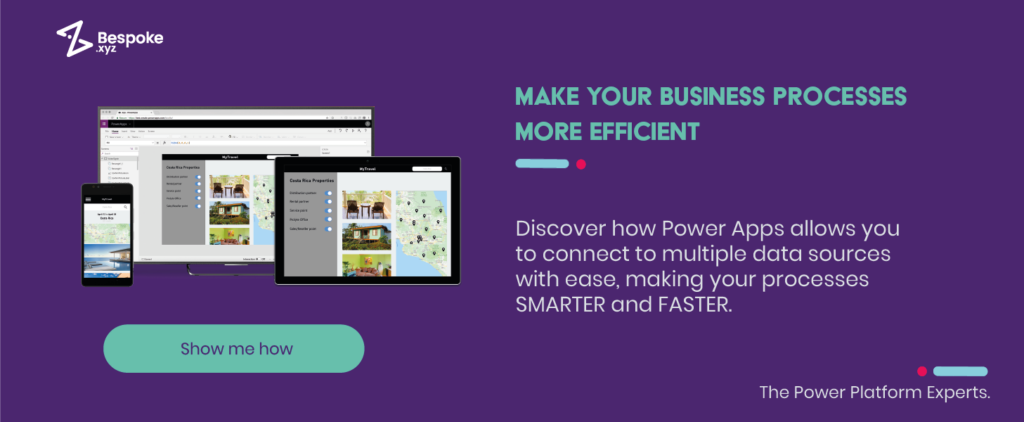Is your data scattered all over the place, making it a headache to manage? You’re not alone. We work with a lot of businesses struggling with data spread across documents, spreadsheets, and systems, which leads to inefficiencies and compliance nightmares.
Think about the frustration of hunting down crucial info hidden in different places or the panic of missing a compliance deadline because you couldn’t find what you needed. It’s chaotic and stressful, right?
This is where Microsoft Power Platform really shines. With its powerful tools (some of which you’re probably already using), you can centralise all your data into one easy-to-access spot, streamline your processes, and boost accuracy.
In this blog, we’ll show you how to harness the Power Platform for centralised data management, using an inspection process as an example. Ready to take control of your data and say goodbye to chaos? Let’s dive in!
The Challenge: Inefficiencies in Current Data Management Processes
Managing data when it’s scattered across different platforms is a common headache for many businesses. Relying on a mix of documents, spreadsheets, and outdated systems can lead to several issues:
- Time-consuming processes: manually updating spreadsheets or searching for the latest version of a document takes up valuable time that could be spent on more important tasks.
- Prone to errors: when data is entered manually across multiple platforms, the risk of mistakes increases. A small error in one document can snowball into bigger issues down the line.
- Difficulty in tracking and managing: with data spread out, tracking progress and managing tasks becomes a nightmare. It’s challenging to keep tabs on who updated what and when.
- Compliance and audit challenges: regulatory requirements often demand quick access to accurate data. When information is scattered, meeting these requirements can be stressful and time-consuming.
These inefficiencies not only slow down your operations but can also impact your bottom line. Centralising your data can transform these chaotic processes into streamlined, efficient operations.
10 Reasons Centralising Data Matters
Centralising your data is more than just a tech upgrade – it’s a strategic move that can transform your business operations. Here’s why bringing all your data into one cohesive system is a must:
- Efficiency: when all your data is in one place, accessing and updating information becomes simple. It eliminates the need to dig through multiple sources, saving time and reducing frustration.
- Productivity: centralised data allows your team to focus on high-value tasks rather than wasting time on manual data entry and management. Automation of routine tasks frees up your staff to concentrate on activities that drive growth and innovation.
- Accuracy: with a single source of truth, you reduce the risk of errors. Centralised data ensures that everyone is working with the most up-to-date and accurate information, which is critical for making informed decisions.
- Scalability: as your business grows, managing scattered data can become increasingly complex. A centralised system is easier to scale, allowing you to seamlessly add more data and users without compromising performance.
- Client satisfaction: when your team can respond quickly and efficiently, it enhances the overall client experience and satisfaction.
- Competitive edge: embracing centralised data management and automation gives you a competitive advantage. While your competitors are bogged down with inefficient processes, you can operate more smoothly and adapt quickly to market changes.
- Innovation: by automating mundane tasks and centralising data, your team has more bandwidth to focus on innovative projects and strategic initiatives that can propel your business forward.
- Profitability: increased efficiency and productivity, combined with reduced errors and better decision-making, directly contributes to higher profitability. Centralised data management helps you do more with less, optimising your resources for maximum return.
- Adaptability: business is always changing and being able to quickly access and analyse data is crucial. A centralised system allows you to adapt to new trends, regulatory changes, and market demands with ease.
- Insights: With all your data in one place, it’s easier to generate comprehensive reports and gain deeper insights into your business operations. This holistic view enables you to identify trends, track performance, and make data-driven decisions that drive success.
What Centralised Data Looks Like in Practice
In any business, whether it’s vehicle safety checks, health and safety audits, or incident reporting, managing inspections efficiently is essential. With the Power Platform, you can streamline and centralise these inspections.
Here’s an example:
You’ve got a large sales team spread across the country, each responsible for conducting monthly vehicle inspections.
Current Process
- Email reminder: an email is sent to remind staff to conduct the inspection.
- Finding the form: staff members locate the inspection form, either printing it or downloading a digital copy.
- Complete inspection: the inspection is conducted manually, and the form is filled out by hand or on a computer.
- Submit form: the completed form is attached to an email and sent back to the administrator.
- Admin review: the administrator reviews the form manually to identify any issues.
- Actions: necessary actions are taken based on the inspection results.
- Filing the form: the final copy of the form is filed for records.
- Inspection complete
New Process with the Power Platform
Using a custom app built with Power Apps and automating workflows with Power Automate, the new streamlined process looks like this:
- Automated reminder & access: salespeople receive automated notifications on their mobile device (or via email, Teams, etc) to conduct the inspection and open the custom inspection app.
- Conduct inspection: the salesperson follows organised sections in the app (some of which are pre-populated for them) to check items like lights, company branding, tyres, and safety equipment, adding photos and comments directly in the app for any issues found.
- Submit inspection: the completed inspection data is submitted in real-time and stored centrally. If all items pass, the inspection is automatically approved. If any items are marked as failed, the app triggers an automated notification to the administrator with details on the issues, so they don’t need to hunt through the form.
- Administrative review (if needed): administrators access a real-time dashboard showing the status of all inspections, pass/fail rates, and pending actions, allowing them to take necessary actions quickly.
- Inspection complete
By leveraging the Power Platform, this once cumbersome, paper-based process is now a streamlined, efficient system. The result? Increased productivity, enhanced accuracy, and improved satisfaction among employees.
For a more detailed walkthrough, check out the demonstration below.
Other Use Case Examples
The Power Platform is a powerhouse that goes far beyond just vehicle inspections. Here are some other business processes that can be transformed with streamlined, centralised data management and automation:
- Health and Safety audits
- Approvals
- Incident and accident logging
- Client onboarding
- Maintenance scheduling.
- Quality control checks
The Power Platform offers versatile tools that can revolutionise a wide range of business processes. By automating and centralising data management, you can boost efficiency, improve accuracy, and supercharge productivity.
Curious to see how Power Apps can benefit your business? Dive into our blog on Power Apps use cases and benefits for more insights.
Getting Started with Centralised Data Management
Centralising your data management with Power Platform technologies can revolutionise how you handle inspections, audits, onboarding, and more. By automating these processes, you not only save time but also increase accuracy, boost productivity, and enhance overall efficiency. Imagine all your business data being easily accessible, well-organised, and instantly actionable.
Ready to take your data management to the next level? At Bespoke XYZ, we specialise in creating custom solutions tailored to your specific needs. Our team of experts will help you harness the full potential of the Power Platform, ensuring your business operates smoothly and efficiently. Get in touch with us today to learn how we can help you streamline your business processes and centralise your data management. Let’s turn your data into your most valuable asset.


